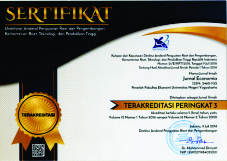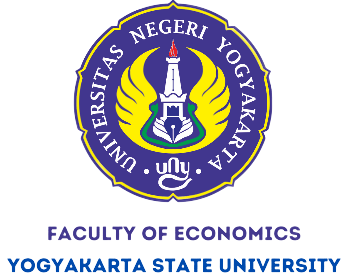Influence of Socioeconomic, Demographics, and Prices Factors on Cooking Fuel Choice of Indonesian Households
Downloads
Abstract
There are differences in the choice of cooking fuel in Indonesian households. Some households still not yet used clean fuel for daily cooking, even though clean energy is crucial and included in the Sustainable Development Goals (SDGs). This study examines the influence of several factors on household's cooking fuel choice using SUSENAS data. This study is based on conceptual framework and theory on several determinant factors, including income, education level of the household head, and energy prices. The testing of the hypothesis used the probit methods. In the estimation results obtained, socioeconomic and demographic factors, namely income, education level of the household head, location of the household in urban areas, positively and significantly impacts the decision to choose clean fuel for cooking. Meanwhile, the price of clean fuel types such as LPG and city gas negatively and significantly impacts the decision to choose clean fuels for cooking in Indonesian households.
Keywords: Demographic Factors; Socioeconomics Factors, Energy Prices; Cooking Fuel Choice, Probit
Downloads
Abebaw, D. (2007). Household determinants of fuelwood choice in urban Ethiopia: a case study of Jimma Town. J. Dev. Areas 41 (1), 117–126.
Akpalu, W., Dasmani, I., & Aglobitse, P. B. (2011). Demand for cooking fuels in a developing country: To what extent do taste and preferences matter? Energy Policy, 39(10), 6525–6531. https://doi.org/10.1016/j.enpol.2011.07.054
Alem, Y., Beyene, A. D., Kí¶hlin, G., & Mekonnen, A. (2016). Modeling household cooking fuel choice: A panel multinomial logit approach. Energy Economics, 59, 129–137. https://doi.org/10.1016/j.eneco.2016.06.025
BPS-Statistics Indonesia. (2014). Survei Sosial Ekonomi Nasional.
BPS-Statistics Indonesia. (2019). Survei Sosial Ekonomi Nasional.
BPS-Statistics Indonesia. (2021). Persentase Rumah Tangga Menurut Provinsi dan Bahan Bakar Utama untuk Memasak Tahun 2001, 2007-2021. Accessed on https://www.bps.go.id/statictable/2014/09/10/1364/persentase-rumah-tangga-menurut-provinsi-dan-bahan-bakar-utama-untuk-memasak-tahun-2001-2007-2021.html
Baiyegunhi, L. J. S., & Hassan, M. B. (2014). Rural household fuel energy transition: evidence from Giwa LGA Kaduna State, Nigeria. Energy for sustainable development, 20, 30-35.
Budya, H., & Arofat, M. Y. (2011). Providing cleaner energy access in Indonesia through the megaproject of kerosene conversion to LPG. Energy Policy, 39(12), 7575–7586. https://doi.org/10.1016/j.enpol.2011.02.061
Chen, J. J., & Pitt, M. M. (2017). Sources of change in the demand for energy by Indonesian households: 1980 – 2002. Energy Economics, 61, 147–161. https://doi.org/10.1016/j.eneco.2016.10.025
Démurger, S., & Fournier, M. (2011). Poverty and firewood consumption: A case study of rural households in northern China. China Economic Review, 22(4), 512–523. https://doi.org/10.1016/j.chieco.2010.09.009
Farsi, M., Filippini, M., & Pachauri, S. (2018). Fuel choices in urban Indian households. Environment and Development Economics, 12(May), 757–774. https://doi.org/10.1017/S1355770X07003932
Gebreegziabher, Z., Mekonnen, A., Kassie, M., & Kí¶hlin, G. (2012). Urban energy transition and technology adoption: The case of Tigrai, northern Ethiopia. Energy Economics, 34(2), 410–418. https://doi.org/10.1016/j.eneco.2011.07.017
Gupta, G., & Kohlin, G. (2006). Preferences for domestic fuel: Analysis with socio-economic factors and rankings in Kolkata, India. Ecological Economics, 57, 107–121. https://doi.org/10.1016/j.ecolecon.2005.03.010
Heltberg, R. (2004). Fuel switching: evidence from eight developing countries. Energy economics, 26(5), 869-887. https://doi.org/10.1016/j.eneco.2004.04.018
Heltberg, R. (2005). Factors determining household fuel choice in Guatemala. Environment and development economics, 10(3), 337-361. https://doi.org/10.1017/S1355770X04001858
Hosier, R. H., & Dowd, J. (1987). Household fuel choice in Zimbabwe. Resources and Energy, 9, 347–361. https://doi.org/10.1016/0165-0572(87)90003-X
International Energy Agency (IEA). (2006) World Energy Outlook. Energy for cooking in developing countries. Paris: International Energy Agency.
International Energy Agency (IEA). (2017). Energy Access Outlook 2017. Paris: International Energy Agency.
Jingchao, Z., & Kotani, K. (2012). The determinants of household energy demand in rural Beijing: Can environmentally friendly technologies be effective? Energy Economics, 34(2), 381–388. https://doi.org/10.1016/j.eneco.2011.12.011
Jumbe, C. B. L., & Angelsen, A. (2011). Modeling choice of fuelwood source among rural households in Malawi: A multinomial probit analysis. Energy Economics, 33(5), 732–738. https://doi.org/10.1016/j.eneco.2010.12.011
Karisma, K. A., Maski, G., & Noor, I. (2016). Analysis of Electricity Consumption Behaviour: Case Study of Non-Business and Business Household in Malang. International Journal of Social and Local Economic Governance (IJLEG), 2(2), 168–176.
Kities, R., Mulder, P., & Rietveld, P. (2014). Energy poverty reduction by fuel switching. Impact evaluation of the LPG conversion program in Indonesia. Energy Policy, 66, 436–449. https://doi.org/10.1016/j.enpol.2013.11.021
Kowsari, R., & Zerriffi, H. (2011). Three-dimensional energy profile: A conceptual framework for assessing household energy use. Energy Policy, 39(12), 7505–7517. https://doi.org/10.1016/j.enpol.2011.06.030
Lay, J., Ondraczek, J., & Stoever, J. (2013). Renewables in the energy transition: Evidence on solar home systems and lighting fuel choice in Kenya. Energy Economics, 40, 350–359. https://doi.org/10.1016/j.eneco.2013.07.024
Leach, G. (1992). The energy transitions. Energy Policy, 20(2), 116-123. https://doi.org/10.1016/0301-4215(92)90105-B
Lee, L. Y. (2013). Household energy mix in Uganda. Energy Economics, 39, 252–261. https://doi.org/10.1016/j.eneco.2013.05.010
Lewis, J. J., & Pattanayak, S. K. (2012). Who Adopts Improved Fuels and Cookstoves? A Systematic Review. Environmental Health Perspective, 120(5), 637–645. https://doi.org/10.1289%2Fehp.1104194
Liao, H., Chen, T., Tang, X., & Wu, J. (2019). Fuel choices for cooking in China: Analysis based on multinomial logit model. Journal of Cleaner Production, 225, 104–111. https://doi.org/10.1016/j.jclepro.2019.03.302
Macauley, M., Naimuddin, M., Agarwal, P. C., & Dunkerley, J. (1989). Fuelwood use in urban areas: a case study of Raipur, India. The Energy Journal, 10(3). DOI: 10.5547/ISSN0195-6574-EJ-Vol10-No3-10
Martey, E. (2019). Tenancy and energy choice for lighting and cooking: Evidence from Ghana. Energy Economics, 80, 570–581. https://doi.org/10.1016/j.eneco.2019.02.008
Ministry of Energy and Mineral Resources (MEMR). (2019). Handbook of Energy & Economic Statistics of Indonesia (HEESI). Jakarta: Ministry of Energy and Mineral Resources
Muller, C., & Yan, H. (2018). Household fuel use in developing countries: Review of theory and evidence. Energy Economics, 70, 429–439. https://doi.org/10.1016/j.eneco.2018.01.024
Nababan, T. S. (2015). Karakteristik Rumah Tangga yang Mempengaruhi Permintaan Energi Listrik Rumah Tangga Sederhana. Jurnal Ekonomi Pembangunan, 16(1), 61–74.
Nazer, M., & Handra, H. (2017). Analisis Konsumsi Energi Rumah Tangga Perkotaan di Indonesia: Periode Tahun 2008 dan 2011. Jurnal Ekonomi Dan Pembangunan Indonesia, 16(2), 141–153.
Ouedraogo, B. (2006). Household energy preferences for cooking in urban Ouagadougou, Burkina Faso. Energy Policy, 34, 3787–3795. https://doi.org/10.1016/j.enpol.2005.09.006
Paudel, U., Khatri, U., & Prasad, K. (2018). Understanding the determinants of household cooking fuel choice in Afghanistan: A multinomial logit estimation. Energy, 156, 55–62. https://doi.org/10.1016/j.energy.2018.05.085
Peng, W., Hisham, Z., & Pan, J. (2010). Household level fuel switching in rural Hubei. Energy for sustainable development, 14(3), 238-244.
Presidential Decree Number 59 of 2017 on Implementation of the Achievement of Sustainable Development Goals
Rahut, D. B., Behera, B., & Ali, A. (2016). Patterns and determinants of household use of fuels for cooking: Empirical evidence from sub-Saharan Africa. Energy, 117, 93–104. https://doi.org/10.1016/j.energy.2016.10.055
Saxena, V., & Bhattacharya, P. C. (2018). Inequalities in LPG and electricity consumption in India: The role of caste, tribe, and religion. Energy for Sustainable Development, 42, 44–53. https://doi.org/10.1016/j.esd.2017.09.009
Schechter, C. (2016). Answer on: Marginal Effects in Probit model for a Log-Transformed Variable. Statalist: The Stata Forum.
https://www.statalist.org/forums/forum/general-stata-discussion/general/
-marginal-effects-in-probit-model-for-a-log-transformed-variable
van der Kroon, B., Brouwer, R., & van Beukering, P. J. H. (2013). The energy ladder: Theoretical myth or empirical truth? Results from a meta-analysis. Renewable and Sustainable Energy Reviews, 20, 504–513. https://doi.org/10.1016/j.rser.2012.11.045
Copyright (c) 2023 Jurnal Economia

This work is licensed under a Creative Commons Attribution 4.0 International License.















